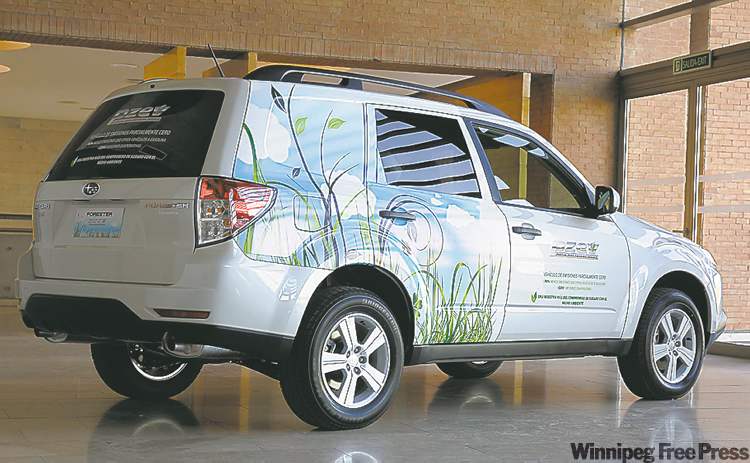2010 SUBARU FORESTER PZEV: Green, but not electric
Subaru Partial Zero Emission Vehicle reduces footprint
Advertisement
Read this article for free:
or
Already have an account? Log in here »
To continue reading, please subscribe:
Monthly Digital Subscription
$1 per week for 24 weeks*
- Enjoy unlimited reading on winnipegfreepress.com
- Read the E-Edition, our digital replica newspaper
- Access News Break, our award-winning app
- Play interactive puzzles
*Billed as $4.00 plus GST every four weeks. After 24 weeks, price increases to the regular rate of $19.00 plus GST every four weeks. Offer available to new and qualified returning subscribers only. Cancel any time.
Monthly Digital Subscription
$4.75/week*
- Enjoy unlimited reading on winnipegfreepress.com
- Read the E-Edition, our digital replica newspaper
- Access News Break, our award-winning app
- Play interactive puzzles
*Billed as $19 plus GST every four weeks. Cancel any time.
To continue reading, please subscribe:
Add Winnipeg Free Press access to your Brandon Sun subscription for only
$1 for the first 4 weeks*
*$1 will be added to your next bill. After your 4 weeks access is complete your rate will increase by $0.00 a X percent off the regular rate.
Read unlimited articles for free today:
or
Already have an account? Log in here »
Hey there, time traveller!
This article was published 17/09/2010 (5492 days ago), so information in it may no longer be current.
LETHBRIDGE, Alta. — When car buyers think of going green, an obvious choice in this era of environmental awareness would be hybrid technology.
Hybrids, utilizing gasoline-powered engines augmented by electric motors to increase fuel economy, are growing in popularity as more consumers try to leave a smaller carbon footprint.
While hybrid cars, sport utility vehicles and even trucks do consume less fuel, they also have disadvantages. One of the most noticeable is the reduction in usable cargo space because of the room needed to house battery packs.

Hybrids also are more expensive than other vehicles, which means recovering the money saved in lower fuel consumption could be a lengthy proposition.
For buyers concerned about the environment who still want good fuel economy without paying substantially more to lessen their impact on nature, Subaru has an alternative in what it calls a Partial Zero Emission Vehicle. That term should actually be plural because Subaru offers PZEV technology in several models, including the Legacy, Outback and Forester.
Subaru press information calls PZEV “the cleanest-running gasoline-powered car on the market today and has been developed to meet California vehicle emissions standards — the most progressive and stringent of any state or province in North America.”
PZEVs, says Subaru, are defined by the California Air Resources Board “as one that meets their state’s Super Ultra Low Emissions Vehicle tailpipe standard which is 90 per cent cleaner than the average new automobile.
In addition, PZEV must have zero evaporative emissions, which are produced when fuel evaporates. This combination makes the PZEV one of the cleanest gas-powered vehicles on the planet and a strong combatant in the fight against smog.”
What this means is a buyer can respect the environment without sacrificing cargo space or performance. And a buyer can do it on regular gas with fuel economy of 10.4 litres per 100 kilometres city and 7.7 L/100 km highway.
In the case of the tester, a Subaru Forester PZEV, buyers get a fully equipped, five-passenger SUV with a slightly modified version of the four-cylinder 2.5-litre Boxer engine that propels most Subaru models. This 170-horsepower engine features i-Active Valve Lift System (I have no clue what that means, to be honest) and other PZEV equipment, according to Subaru.
Purchasers of PZEVs will have to sacrifice a bit of the higher-end equipment some buyers prefer, such as leather seats and a sunroof, available on the Forester 2.5X Limited package, which adds numerous features including Sirius satellite radio, a six-disc premium audio system and Xenon high-intensity discharge headlamps.
The PZEV Forester is well-equipped with a 10-way power adjustable driver’s seat, four-speaker sound system with AM/FM/CD/MP3 and MWA capability. It also has a tilting and telescoping steering wheel and power everything.
Safety features include four-channel, four-wheel anti-lock brakes, brake assist and electronic brake-force distribution.
The Forester PZEV has a starting suggested price of $28,095. It has the same smooth, quiet ride and comfortable cabin as other Forester models and the same superb symmetrical full-time all-wheel-drive system.
The Forester has a low step-in height, which makes it an ideal choice for drivers of any stature, yet the riding position is relatively high, providing an expansive view of the road. The rear seat will actually fit three adults in comfort with lots of legroom and good thigh support on the split-folding bench.
The Forester has long been among my favourite SUV/crossover-type vehicles. It is perfectly sized, well-mannered, fuel-efficient and fun to drive. It is seriously fun. Even without the 224-hp turbo Boxer available in the 2.5XT Limited, the Forester can romp. Around the city, the Forester is a blast with its tight turning radius, instant power and great park-ability.
For long-distance touring and activities, Subaru has plenty of accessories, including ski and snowboard carriers, trailer hitches, a kayak stacker, bike carrier and roof box.
With the Forester, Subaru puts the “sport” into utility and, with the PZEV, does it with a minimal impact on the environment.
With this PZEV technology, innovative Subaru is giving buyers an alternative, one which from this perspective, is a wise one.
Good on ya, Subaru!
— The Canadian Press

